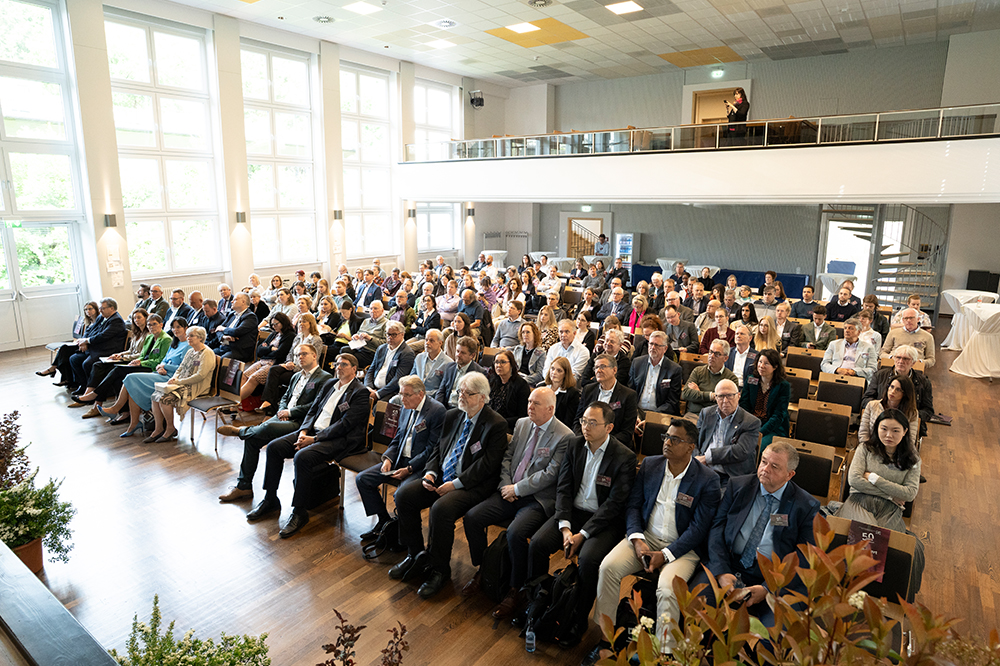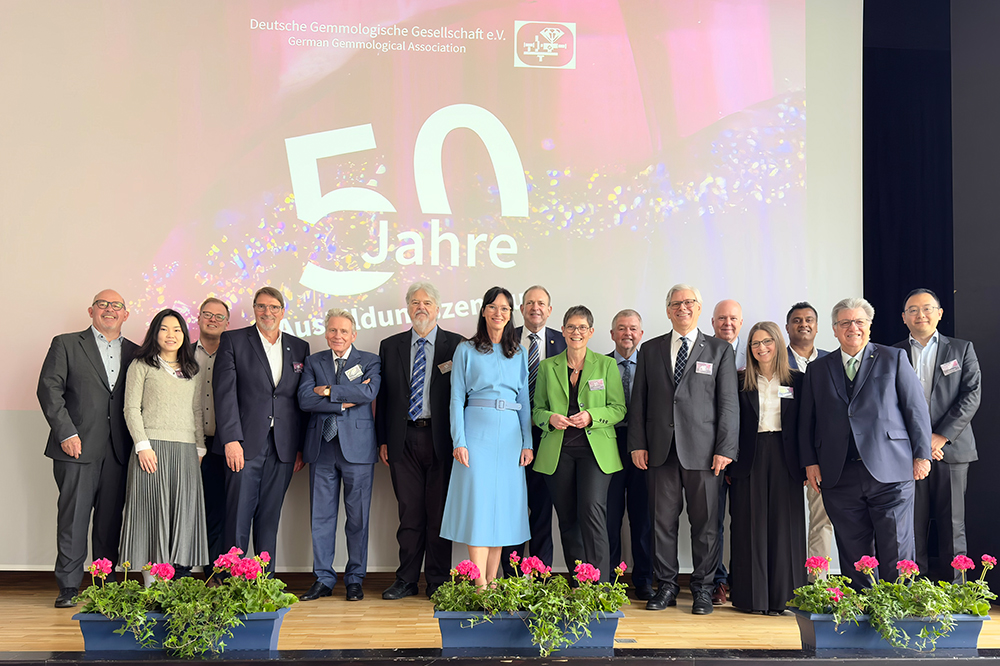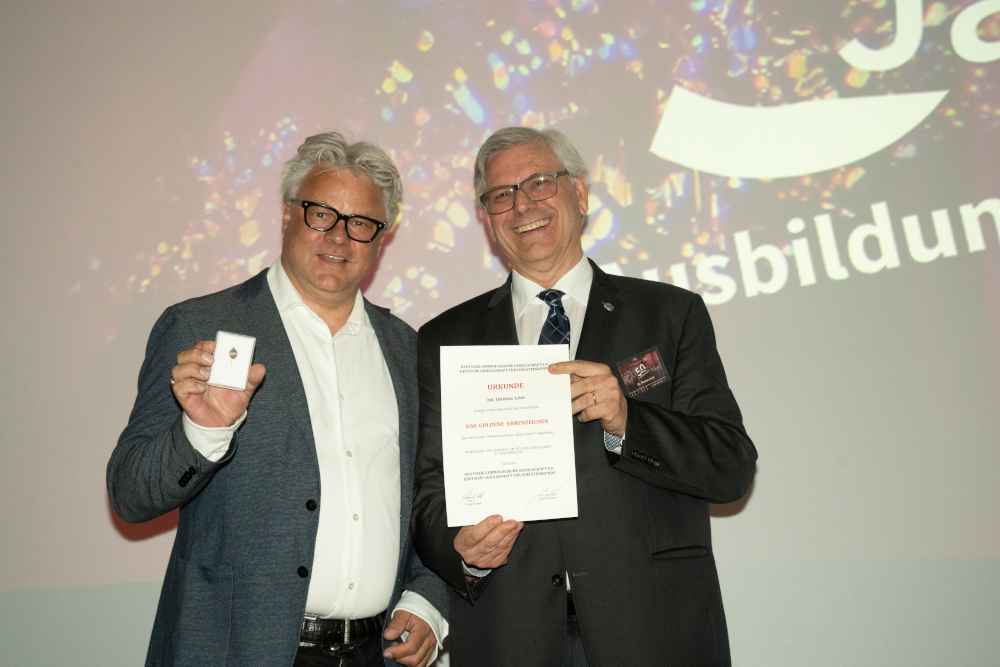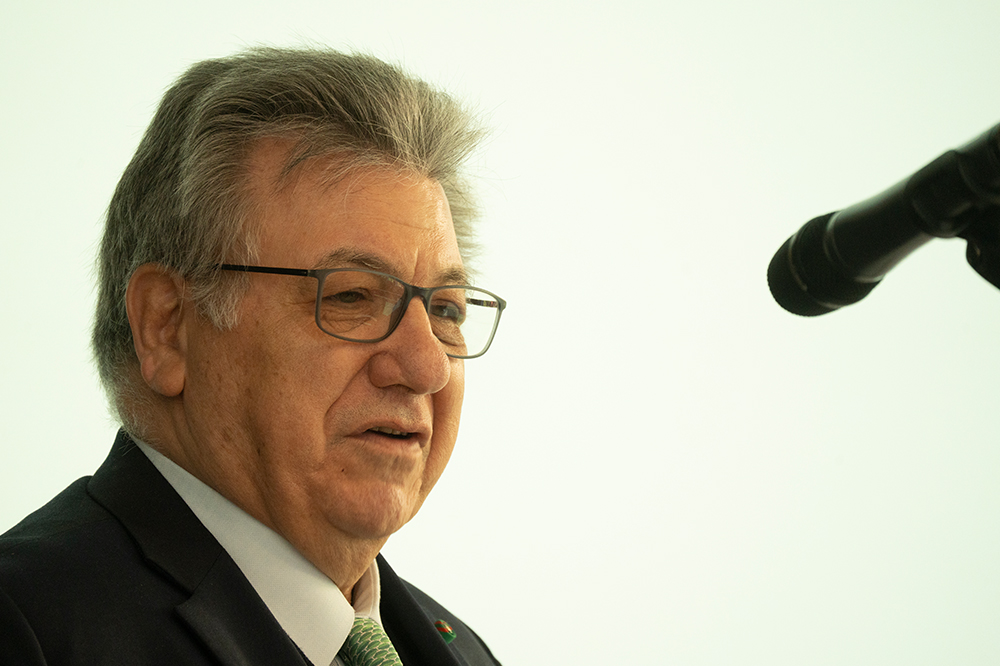
This year, the German Gemmological Association (DGemG) is celebrating the 50th anniversary of its training centre in Idar-Oberstein. The first gemmological seminars were held shortly after the Association’s founding in 1932, but in 1975, a dedicated training centre was opened specifically for the purpose of gemmological education.
The celebratory highlight of the anniversary year was the anniversary conference held from May 23-25, 2025 in Idar-Oberstein, Germany. Over three days, more than 200 participants from more than 10 countries gathered for scientific lectures and informal networking. The conference opened with a welcome reception at the German Gemstone Museum. On Saturday, a series of lectures took place, as well as the graduation ceremony for the DGemG-graduates. In the evening, the participants met for the gemstone party at the DGemG-training centre. On Sunday, in addition to other talks, practical workshops on gemstone examination took place.
 The speakers at the Anniversary Confernce. From left to right: Dr. Claudio C. Milisenda, Qi Wang, Dr. Tom Stephan, Dr. Ulrich Henn, Kenneth Scarrat, Shane McClure, Dr. Heide Rezepa-Zabel, Frank Frühauf, Petra Dick-Walther, Peter Lyckberg, Dr. Thomas Lind, Dr. Hanco Zwaan, Dr Ilaria Adamo, Umesh Wariyapperuma, Dr. Gaetano Cavalieri, Dr. Hao A. O. Wang. Photo: Niels Ruddy Hansen, Denmark.
The speakers at the Anniversary Confernce. From left to right: Dr. Claudio C. Milisenda, Qi Wang, Dr. Tom Stephan, Dr. Ulrich Henn, Kenneth Scarrat, Shane McClure, Dr. Heide Rezepa-Zabel, Frank Frühauf, Petra Dick-Walther, Peter Lyckberg, Dr. Thomas Lind, Dr. Hanco Zwaan, Dr Ilaria Adamo, Umesh Wariyapperuma, Dr. Gaetano Cavalieri, Dr. Hao A. O. Wang. Photo: Niels Ruddy Hansen, Denmark.
The lecture series opened with welcoming remarks from Petra Dick-Walther, State Secretary of the Ministry of Economics in Rhineland-Palatinate, Germany, and Frank Frühauf, Lord Mayor of Idar-Oberstein. CIBJO-President Dr. Gaetano Cavalieri emphasized the internation relevance of gemmological training and continuing education, and the significant contribution made by the German Gemmological Association.
Dr. Thomas Lind, President of DGemG, welcomed the audience and emphasized in his keynote speed that sound gemmological knowledge is now more than ever a key success factor in the jewellery and gemstone industry.
In his presentation on the history of the training centre, Dr. Ulrich Henn, former CEO of DGemG, discussed the changes in gemmology over the past decades and the associated new challenges for practicing gemmologists – from the discovery of new gemstones, varieties and occurrences, to new synthetics and modern treatment methods, the increased focus on topics such as sustainability and authenticity, and the current enormous increase in the production of synthetic diamonds. All of these new requirements have also strongly influenced the development of the training centre, as well as the focus of gemmological training and continuing education worldwide.
Dr. Ilaria Adamo (Italian Gemmological Institute and Chairwomen of the Federation for European Education in Gemmology – FEEG) discussed the distinction between natural and synthetic red beryl. In addition to the typical inclusion pattern of hydrothermal synthetic beryl, especially with their swirly growth inhomogeneities, also advanced methods like infrared spectroscopy or chemical analysis allow a differentiation of both materials.
Dr. Hanco Zwaan, Director of the NEL Netherlands Gem Laboratory, highlighted the essential importance of gemmological research based on practical observations from everyday laboratory work at NEL. He reported on issues ranging from fake certificates to synthetic diamonds bearing matching certificates from natural diamonds to borderline cases in the definition of varieties.
Kenneth Scarrat, CIBJO Vice President and Director of the CIBJO Academy, emphasized the importance of transparency and the correct application of nomenclatural standards in the jewellery and gemstone industry to build long-term trust with the end consumer. A thorough understanding of standards such as the iconic CIBJO Blue Books requires a thorough gemmological education.
In her lecture, the art historian Dr. Heide Rezepa-Zabel used picturesque examples to illustrate the complexity of correctly classifying and categorizing the historic background of an artifact or piece of jewellery. She particularly emphasized the importance of combining gemmology and art history.
Peter Lyckberg, who is known for his travels to gemstone deposits, especially pegmatitic ones, gave an insight into the formation of gemstones. Using numerous images from his travels, he presented the geological conditions in the formation of gemstones in pegmatites and, in particular the requirements and challenges for mining such deposits.
Umesh Wariyapperuma from Sri Lanka, as Managing Director of Ceylon Gem Traders, is also involved in gemstone mining. With his projects, he and his team won the Gold Award in the Gem and Jewellery Sector of the International Conference on Sustainable Globalization in 2024 and 2025. In his presentation, he presented the current status of gemstone mining in Sri Lanka, which is already sustainable in many areas, and demonstrated how progress can be made in this direction in the future, from climate actions to gender equality.
Dr. Hao A O. Wang, a research scientist at SSEF, addressed the growing importance of artificial intelligence in gemstone analysis in gemmological laboratories. Using Paraíba tourmalines as an example, he presented the possibilities of using artificial intelligence in data analysis, but also clearly pointed out its limitations. In his opinion, AI’s true value lies in augmenting the capabilities of gemmologists – acting as a powerful assistant that enhances efficiency, expands analytical depth, and paves the way for new discoveries in gemmological research.
Shane McClure, Global Director of Colored Stone Services at the GIA, spoke about the difficulties involved in distinguishing certain varieties in the gemstone trade. Using the example of distinguishing green beryls and emeralds, especially those from Nigeria coloured mainly by iron as well as traces of chromium and vanadium, he highlighted the challenges involved in such issues and emphasised that in some cases, differentiation is impossible without specialized laboratory equipment.
The final lecture on Saturday was given by Dr. Claudio C. Milisenda, CEO of the DSEF German Gem Lab. In his presentation, he discussed the gemstone deposits associated with the Pan-African Event, one of the most important tectonic events in Earth’s history (late Precambrian to early Paleozoic). Important examples of gemstones from this event include the corundum deposits of East Africa, Madagascar and Sri Lanka; tanzanite, tsavolite and other garnets in East Africa; the emerald deposits of Zambia; and the Brazilian and African Paraíba tourmalines.
 During the graduation ceremony, Dr. Thomas Lind (right), President of DGemG for 25 years now, was awarded with the Association’s Golden Badge of Honour by DGemG-Vice President Constantin Wild. Photo: Foto Hosser, Idar-Oberstein, Germany.
During the graduation ceremony, Dr. Thomas Lind (right), President of DGemG for 25 years now, was awarded with the Association’s Golden Badge of Honour by DGemG-Vice President Constantin Wild. Photo: Foto Hosser, Idar-Oberstein, Germany.
At the conclusion of the lectures on Saturday, 69 graduates of the DGemG educational programmes received their qualification certificates before heading off to the gemstone party at the DGemG training centre. A special highlight during the graduation ceremony was the awarding of the Golden Badge of Honour of the German Gemmological Association for his outstanding services to the association to Dr. Thomas Lind, DGemG-president for 25 years now, by Vice-President Constantin Wild.
Three more lectures took place on Sunday. Rui Galopim de Carvalho, a Gem Education Consultant from Portugal, opened the day with his speech about the history of rubies, discussing their historical naming and deposits, as well as the development of synthetic rubies and ruby treatments. Among others, he emphasized the fact, that many pink sapphires to nowadays standards, were historically described as ruby, or often as pink ruby or even elegantly as feminine rubies.
Qi Wang, lecturer and research gemmologist at DGemG, presented the most common testing devices currently available for the rapid examination of colourless natural and synthetic diamonds, focusing in particular on their limitations and demonstrating the possibilities of classical gemmological examination methods such as luminescence under long- and shortwave UV, as well as tension structures under crossed polarization filters. Using a combination of these methods, many natural and synthetic diamonds can be identified with rather simple methods. However, she emphasized that it requires a lot of experience, especially for more difficult examples like some natural IIa-diamonds.
The concluding lecture was held by Dr. Tom Stephan, CEO of the German Gemmological Association (DGemG), on the possibilities that have arisen for gemmologists in recent years thanks to the development of mobile spectrometers. The use of optical fibers, in particular, allows many questions to be answered even for gemstones mounted in jewellery, such as the detection of copper in Paraíba tourmalines or the artificial colouration of turquoise. He emphasized, that such investigations are no longer reserved exclusively for gemmological laboratories, but can also be performed by gemmologists with appropriate training.
Parallel to the lectures on Sunday, participants were able to gain insights into gemstone examination in the DGemG seminar rooms. One workshop covered the examination of natural and synthetic diamonds under crossed polarization filters and with the help of long- and shortwave UV. Two other workshops offered the opportunity to examine solid, liquid and gaseous inclusions, as well as structural characteristics in natural and synthetic stones. Each stone was accompanied by a display explaining the key information for the examination.







